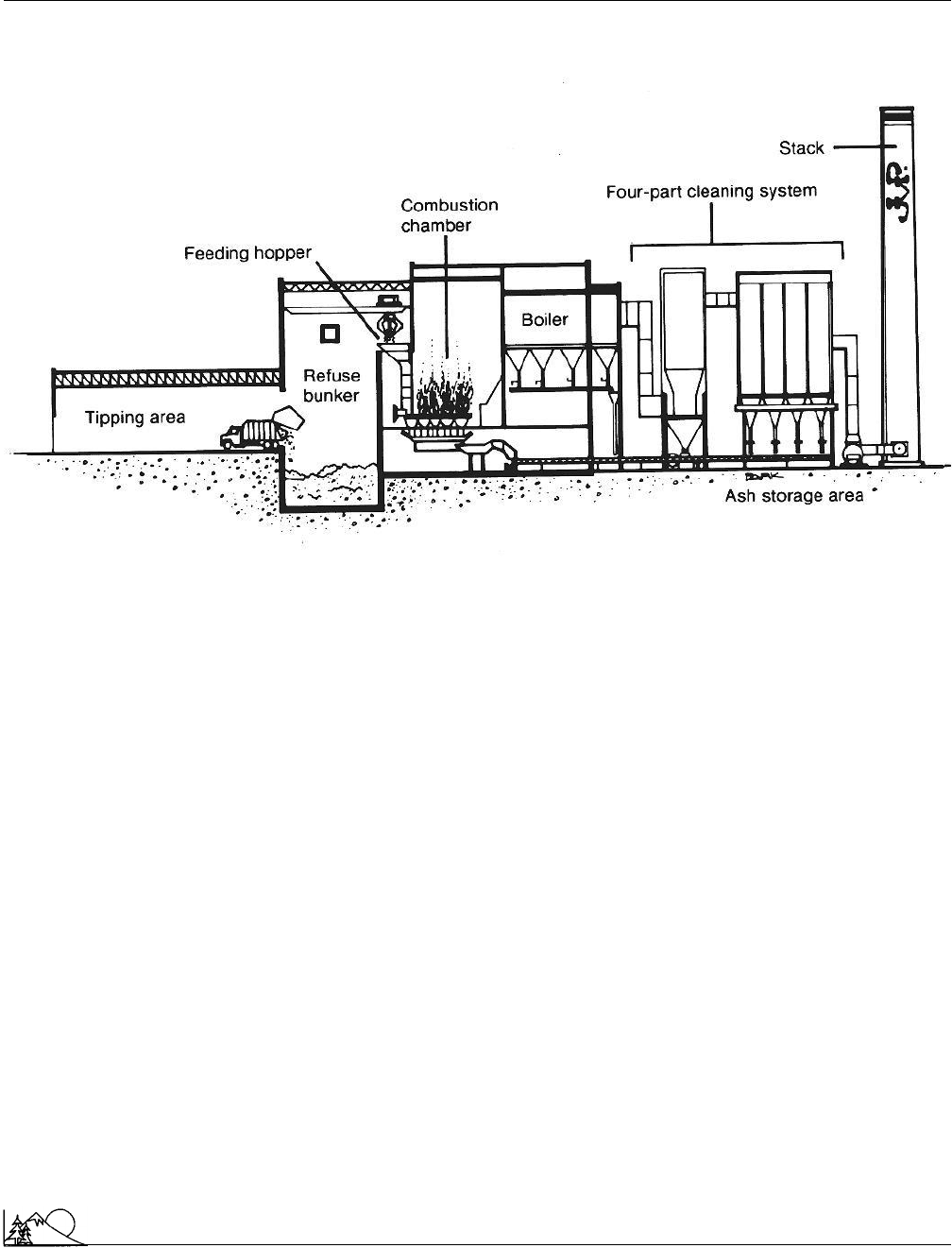Environmental Encyclopedia
Подождите немного. Документ загружается.


Environmental Encyclopedia 3
Incineration
Diagram of a municipal incinerator. (McGraw-Hill Inc. Reproduced by permission.)
systems which neutralizes the
acid
gases (
sulfur dioxide
and hydrochloric acid, the latter resulting from burning chlo-
rinated plastic products), followed by gas
scrubbers
and
then solid/gas separation systems such as baghouses before
dischargement to
tall stacks
. The stack system contains a
variety of sensing and control devices to enable the furnace
to operate at maximum efficiency consistent with minimal
particulate
emissions. A continuous log of monitoring sys-
tems is also required for compliance with county and state
environmental quality regulations.
There are several products from a municipal incinerator
system: items which are removed before combustion such as
large metal pieces; grate or bottom ash (which is usually water-
sprayed after removal from the furnace for safe storage); fly
(or top ash) which is removed from the flue system generally
mixed with products from the acid neutralization process; and
finally the flue gases which are expelled to the
environment
.
If the system is operating optimally, the flue gases will meet
emission
requirements, and the
heavy metals
from the
wastes will be concentrated in the
fly ash
. (Typically these
heavy metals, which originate from volatile metallic constit-
uents, are
lead
and arsenic.) The fly ash typically is then stored
747
in a suitable landfill to avoid future problems of
leaching
of
heavy metals. Some municipal systems blend the bottom ash
with the top ash in the plant in order to reduce the level of
heavy metals by dilution. This practice is undesirable from an
ultimate environmental viewpoint.
There are many advantages and disadvantages to mu-
nicipal waste incineration. Some of the advantages are as
follows: 1) The waste volume is reduced to a small fraction
of the original. 2) Reduction is rapid and does not require
semi-infinite residence times in a landfill. 3) For a large
metropolitan area, waste can be incinerated on site, minimiz-
ing
transportation
costs. 4) The ash residue is generally
sterile, although it may require special disposal methods. 5)
By use of gas clean-up equipment, discharges of flue gases
to the environment can meet stringent requirements and be
readily monitored. 6) Incinerators are much more compact
than landfills and can have minimal odor and vermin prob-
lems if properly designed. 7) Some of the costs of operation
can be reduced by heat-recovery techniques such as the sale
of steam to municipalities or electrical energy generation.
There are disadvantages to municipal waste incinera-
tion as well. For example: 1) Generally the capital cost is

Environmental Encyclopedia 3
Indicator organism
high and is escalating as
emission standards
change. 2)
Permitting requirements are becoming increasingly more
difficult to obtain. 3) Supplemental fuel may be required
to burn municipal wastes, especially if
yard waste
is not
removed prior to collection. 4) Certain items such as mer-
cury-containing batteries can produce emissions of
mercury
which the gas cleanup system may not be designed to remove.
5) Continuous skilled operation and close maintenance of
process control is required, especially since stack monitoring
equipment reports any failure of the equipment which could
result in mandated shut down. 6) Certain materials are not
burnable and must be removed at the source. 7) Traffic to
and from the incinerator can be a problem unless timing
and routing are carefully managed. 8) The incinerator, like
a landfill, also has a limited life, although its lifetime can
be increased by capital expenditures. 9) Incinerators also
require landfills for the ash. The ash usually contains heavy
metals and must be placed in a specially-designed landfill
to avoid leaching.
Hazardous waste incineration
For the incineration of hazardous waste, a greater de-
gree of control, higher temperatures, and a more rigorous
monitoring system are required. An incinerator burning haz-
ardous waste must be designed, constructed, and maintained
to meet
Resource Conservation and Recovery Act
(RCRA) standards. An incinerator burning hazardous waste
must achieve a destruction and removal efficiency of at least
99.99 percent for each principal organic hazardous constit-
uent. For certain listed constituents such as polychlorinated
biphenyl (PCB), mass air emissions from an incinerator are
required to be greater than 99.9999%. The Toxic Substances
Control Act requires certain standards for the incineration
of PCBs. For example, the flow of PCB to the incinerator
must stop automatically whenever the combustion tempera-
ture drops below the specified value; there must be continu-
ous monitoring of the stack for a list of emissions; scrubbers
must be used for hydrochloric acid control; among others.
Recently medical wastes have been treated by steam
sterilization, followed by incineration with treatment of the
flue gases with activated
carbon
for maximum
absorption
of organic constituents. The latter system is being installed
at the Mayo Clinic in Rochester, Minnesota, as a model
medical disposal system. See also Fugitive emissions; Solid
waste incineration; Solid waste volume reduction; Stack
emissions
[Malcolm T. Hepworth]
R
ESOURCES
B
OOKS
Brunner, C. R. Handbook of Incineration Systems. New York: McGraw-
Hill, 1991.
748
Edwards, B. H., et al. Emerging Technologies for the Control of Hazardous
Wastes. Park Ridge, NJ: Noyes Data Corporation, 1983.
Hickman Jr., H. L., et al. Thermal Conversion Systems for Municipal Solid
Waste. Park Ridge, NJ: Noyes Publications, 1984.
Vesilind, R. A., and A. E. Rimer. Unit Operations in Resource Recovery
Engineering. Englewood Cliffs, NJ: Prentice-Hall, 1981.
Wentz, C. A. Hazardous Waste Management. New York: McGraw-Hill,
1989.
Incineration, solid waste
see
Solid waste incineration
Indicator organism
Indicator organisms, sometimes called bioindicators, are
plant or animal
species
known to be either particularly
tolerant or particularly sensitive to
pollution
. The health of
an organism can often be associated with a specific type or
intensity of pollution, and its presence can then be used to
indicate polluted conditions relative to unimpacted condi-
tions.
Tubificid worms are an example of organisms that
can indicate pollution. Tubificid worms live in the bottom
sediments of streams and lakes, and they are highly tolerant
of sewage. In a river polluted by
wastewater discharge
from a
sewage treatment
plant, it is common to see a
large increase in the numbers of tubificid worms in stream
sediments immediately downstream. Upstream of the dis-
charge, the numbers of tubificid worms are often much lower
or almost absent, reflecting cleaner conditions. The number
of tubificid worms also decreases downstream, as the dis-
charge is diluted.
Pollution-intolerant organisms can also be used to in-
dicate polluted conditions. The larvae of mayflies live in
stream sediments and are known to be particularly sensitive
to pollution. In a river receiving wastewater discharge, may-
flies will show the opposite pattern of tubificid worms. The
mayfly larvae are normally present in large numbers above
the discharge point; they decrease or disappear at the dis-
charge point and reappear further downstream as the effects
of the discharge are diluted.
Similar examples of indicator organisms can be found
among plants, fish, and other biological groups. Giant reed-
grass (Phragmites australis) is a common marsh plant that is
typically indicative of disturbed conditions in
wetlands
.
Among fish, disturbed conditions may be indicated by the
disappearance of sensitive species like trout which require
clear, cold waters to thrive.
The usefulness of indicator organisms is limited.
While their presence or absence provides a reliable general
picture of polluted conditions, they are often little help in

Environmental Encyclopedia 3
Indigenous peoples
identifying the exact sources of pollution. In the sediments
of New York Harbor, for example, pollution-tolerant insect
larvae are overwhelmingly dominant. However, it is impossi-
ble to attribute the large larval populations to just one of
the sources of pollution there, which include ship traffic,
sewage and industrial discharge, and
storm runoff
.
The U.S.
Environmental Protection Agency
(EPA)
is working diligently to find reliable predictors of aquatic
ecosystem health
using indicator species. Recently, the
EPA has developed standards for the usefulness of species
as ecological indicator organisms. A potential indicator spe-
cies for use in evaluating
watershed
health must successfully
pass four phases of evaluation. First, a potential indicator
organism should provide information that is relevant to soci-
etal concerns about the
environment
, not simply academi-
cally interesting information. Second, use of a potential indi-
cator organism should be feasible. Logistics, sampling costs,
and timeframe for information gathering are legitimate con-
siderations in deciding whether an organism is a potential
indicator species or not. Thirdly, enough must be known
about a potential species before it may be effectively used
as an indicator organism. Sufficient knowledge regardin! g
the natural variations to environmental flux should exist
before incorporating a species as a true watershed indicator
species. Lastly, the EPA has set a fourth criterion for evalua-
tion of indicator species. A useful indicator should provide
information that is easily interpreted by policy makers and
the public, in addition to scientists.
Additionally, in an effort to make indicator species
information more reliable, the creation of indicator species
indices are being investigated. An index is a formula or ratio
of one amount to another that is used to measure relative
change. The major advantage of developing an indicator
organism index that is somewhat universal to all aquatic
environments is that it can be tested using
statistics
. Using
mathematical statistical methods, it may be determined
whether a significant change in an index value has occurred.
Furthermore, statistical methods allow for a certain level of
confidence that the measured values repres! ent what is actu-
ally happening in
nature
. For example, a study was con-
ducted to evaluate the utility of diatoms (a kind of micro-
scopic aquatic algae) as an index of aquatic system health.
Diatoms meet all four criteria mentioned above, and various
species are found in both fresh and salt water. An index
was created that was calculated using various measurable
characteristics of diatoms that could then be evaluated statis-
tically over time and among varying sites. It was determined
that the diatom index was sensitive enough to reliably reflect
three categories of the health of an aquatic
ecosystem
.
The diatom index showed that values obtained from areas
impacted by human activities had greater variability over
time than diatom indices obtained from less disturbed loca-
749
tions. Many such indices are being developed using different
species, and multiple species in an effort to create reliable
information from indicator organisms. As more is learned
about the physiology and life history of indicator organisms
and their individual responses to different types of pollution,
it may be possible to draw more specific conclusions. See
also Algal bloom; Nitrogen cycle; Water pollution
[Terry Watkins]
R
ESOURCES
B
OOKS
Browder, J. A., ed. Aquatic Organisms As Indicators of Environmental Pollu-
tion. Bethesda, MD: American Water Resources Association, 1988.
Connell, D. W., and G. J. Miller. Chemistry and Ecotoxicology of Pollution.
New York: Wiley-Interscience, 1984.
Indigenous peoples
Cultural or ethnic groups living in an area where their culture
developed or where their people have existed for many gener-
ations. Most of the world’s indigenous peoples live in remote
forests, mountains, deserts, or arctic
tundra
, where modern
technology, trade, and cultural influence are slow to pene-
trate. Many had much larger territories historically but have
retreated to, or been forced into, small, remote areas by the
advance of more powerful groups. Indigenous groups, also
sometimes known as native or tribal peoples, are usually
recognized in comparison to a country’s dominant cultural
group. In the United States the dominant, non-indigenous
cultural groups speak English, has historic roots in Europe,
and maintain strong economic, technological, and commu-
nication ties with Europe, Asia, and other parts of the world.
Indigenous groups in the United States, on the other hand,
include scores of groups, from the southern Seminole and
Cherokee to the Inuit and Yupik peoples of the Arctic coast.
These groups speak hundreds of different languages or dia-
lects, some of which have been on this continent for thou-
sands of years. Their traditional economies were based
mainly on small-scale subsistence gathering,
hunting
, fish-
ing, and farming. Many indigenous peoples around the world
continue to engage in these ancient economic practices.
It is often difficult to distinguish who is and who is
not indigenous. European-Americans and Asian-Americans
are usually not considered indigenous even if they have been
here for many generations. This is because their cultural
roots connect to other regions. On the other hand, a German
residing in Germany is also not usually spoken of as indige-
nous, even though by any strict definition she or he is indige-
nous. This is because the term is customarily reserved to
denote economic or political minorities—groups that are
relatively powerless within the countries where they live.

Environmental Encyclopedia 3
Indonesian forest fires
Historically, indigenous peoples have suffered great
losses in both population and territory to the spread of larger,
more technologically advanced groups, especially (but not
only) Europeans. Hundreds of indigenous cultures have dis-
appeared entirely just in the past century. In recent decades,
however, indigenous groups have begun to receive greater
international recognition, and they have begun to learn effec-
tive means to defend their lands and interests—including
attracting international media attention and suing their own
governments in court. The main reason for this increased
attention and success may be that scientists and economic
development organizations have recently become interested
in biological diversity and in the loss of world rain forests.
The survival of indigenous peoples, of the world’s forests,
and of the world’s gene pools are now understood to be
deeply interdependent. Indigenous peoples, who know and
depend on some of the world’s most endangered and biologi-
cally diverse ecosystems, are increasingly looked on as a
unique source of information, and their subsistence econo-
mies are beginning to look like admirable alternatives to
large-scale
logging
, mining, and conversion of jungles to
monocrop agriculture.
There are probably between 4,000 and 5,000 different
indigenous groups in the world; they can be found on every
continent (except
Antarctica
) and in nearly every country.
The total population of indigenous peoples amounts to be-
tween 200 million and 600 million (depending upon how
groups are identified and their populations counted) out of
a world population just over 6.2 billion. Some groups number
in the millions; others comprise only a few dozen people.
Despite their world-wide distribution, indigenous groups
are especially concentrated in a number of “cultural diversity
hot spots,” including Indonesia, India, Papua New Guinea,
Australia
, Mexico, Brazil, Zaire, Cameroon, and Nigeria.
Each of these countries has scores, or even hundreds, of
different language groups. Neighboring valleys in Papua
New Guinea often contain distinct cultural groups with un-
related languages and religions. These regions are also recog-
nized for their unusual biological diversity. Both indigenous
cultures and
rare species
survive best in areas where modern
technology does not easily penetrate. Advanced technologi-
cal economies involved in international trade consume tre-
mendous amounts of land, wood, water, and minerals. Indig-
enous groups tend to rely on intact ecosystems and on a
tremendous variety of plant and animal
species
. Because
their numbers are relatively small and their technology sim-
ple, they usually do little long-lasting damage to their
envi-
ronment
despite their dependence on the resources around
them. The remote areas where indigenous peoples and their
natural environment survive, however, are also the richest
remaining reserves of
natural resources
in most countries.
Frequently state governments claim all timber, mineral,
750
water, and land rights in areas traditionally occupied by tribal
groups. In Indonesia, Malaysia, Burma (Myanmar), China,
Brazil, Zaire, Cameroon, and many other important cultural
diversity regions, timber and mining concessions are fre-
quently sold to large or international companies that can
quickly and efficiently destroy an ecological area and its
people. Usually native peoples, because they lack political
and economic clout, have no recourse to losing their homes.
Generally they are relocated, attempts are made to integrate
them into mainstream culture, and they join laboring classes
in the general economy.
Indigenous rights have begun to strengthen in recent
years. As long as international media attention continues to
give them the attention they need—especially in the form
of international economic and political pressure on state
governments—and as long as indigenous leaders are able to
continue developing their own defense strategies and legal
tactics, the survival rate of indigenous peoples and their
environments may improve significantly.
[Mary Ann Cunningham Ph.D.]
R
ESOURCES
B
OOKS
Redford, K. H., and C. Padoch. Conservation of Neotropical Forests: Working
from Traditional Resources Use. New York: Columbia University Press, 1992.
O
THER
Durning, A. T. “Guardians of the Land: Indigenous Peoples and the Health
of the Earth.” Worldwatch Paper 112. Washington, DC: Worldwatch Insti-
tute, 1992.
Indonesian forest fires
For several months in 1997 and 1998, a thick pall of
smoke
covered much of Southeast Asia. Thousands of forest fires
burning simultaneously on the Indonesian islands of Kali-
mantan (Borneo) and Sumatra, are thought to have de-
stroyed about 8,000 mi
2
(20,000 km
2
) of primary forest, or
an area about the size of New Jersey. The smoke generated
by these fires spread over eight countries and 75 million
people, covering an area larger than Europe. Hazy skies and
the smell of burning forests could be detected in Hong
Kong, nearly 2,000 mi (3,200 km) away. The
air quality
in Singapore and the city of Kuala Lumpur, Malaysia, just
across the Strait of Malacca from Indonesia, was worse than
any industrial region in the world. In towns such as Palem-
bang, Sumatra, and Banjarmasin, Kalimantan, in the heart
of the fires, the
air pollution index
frequently passed 800,
twice the level classified in the United States as an air quality
emergency, hazardous to human health. Automobiles had
to drive with their headlights on, even at noon. People

Environmental Encyclopedia 3
Indonesian forest fires
groped along smoke-darkened streets unable to see or
breathe normally.
At least 20 million people in Indonesia and Malaysia
were treated for illnesses such as
bronchitis
, eye irritation,
asthma
,
emphysema
, and cardiovascular diseases. It’s
thought that three times that many who couldn’t afford
medical care went uncounted. The number of extra deaths
from this months-long episode is unknown, but it seems
likely to have been hundreds of thousands, mostly elderly
or very young children. Unable to see through the thick
haze
, several boats collided in the busy Straits of Malacca,
and a plane crashed on Sumatra, killing 234 passengers.
Cancelled airline flights, aborted tourist plans, lost workdays,
medical bills, and ruined crops are estimated to have cost
countries in the afflicted area several billion dollars.
Wildlife
suffered as well. In addition to the loss of
habitat
destroyed
by fires, breathing the noxious smoke was as hard on wild
species
as it was on people. At the Pangkalanbuun Conser-
vation Reserve, weak and disoriented orangutans were found
suffering from
respiratory diseases
much like those of
humans.
Geographical isolation on the 16,000 islands of the
Indonesian archipelago has allowed
evolution
of the world’s
richest collection of
biodiversity
. Indonesia has the second
largest expanse of tropical forest and the highest number
of
endemic species
anywhere. This makes destruction of
Indonesian plants, animals, and their habitat of special con-
cern. The dry season in tropical Southeast Asia has probably
always been a time of burning vegetation and smoky skies.
Farmers practicing traditional
slash and burn agriculture
start fires each year to prepare for the next growing season.
Because they generally burn only a hectare or two at a time,
however, these shifting cultivators often help preserve plant
and animal species by opening up space for early successional
forest stages. Globalization and the advent of large, commer-
cial plantations, however, have changed agricultural dynam-
ics. There is now economic incentive for clearing huge tracts
of forestland to plant oil palms, export foods such as pineap-
ples and sugar cane, and fast-growing eucalyptus trees. Fire
is viewed as the only practical way remove
biomass
and
convert wild forest to into domesticated land. While it can
cost the equivalent of $200 to clear a hectare of forest with
chainsaws and bulldozers, dropping a lighted match into dry
underbrush is essentially free.
In 1997 to 1998, the Indonesian forest was unusually
dry. A powerful El Nin
˜
o/Southern Oscillation weather pat-
tern caused the most severe droughts in 50 years. Forests
that ordinarily stay green and moist even during the rainless
season became tinder dry. Lightning strikes are thought to
have started many forest fires, but many people took advan-
tage of the
drought
for their own purposes. Although the
government blamed traditional farmers for setting most of
751
the fires, environmental groups claimed that the biggest fires
were caused by large agribusiness conglomerates with close
ties to the government and military. Some of these fires
were set to cover up evidence of illegal
logging
operations.
Others were started to make way for huge oil-palm planta-
tions and fast-growing pulpwood trees,
Neil Byron of the Center for International Forestry
Research was quoted as saying that “fire crews would go
into an area and put out the fire, then come back four days
later and find it burning again, and a guy standing there
with a petrol can.” According to the World Wide Fund for
Nature, 37 plantations in Sumatra and Kalimantan were
responsible for a vast majority of the forest burned on those
islands. The plantation owners were politically connected to
the ruling elite, however, and none of them was ever pun-
ished for violation of
national forest
protection laws. Indo-
nesia has some of the strongest land-use management laws
of any country in the world, but these laws are rarely en-
forced. In theory, more than 80% of its land is in some form
of protected status, either set aside as national parks or
classified as selective logging reserves where only a few trees
per hectare can be cut. The government claims to have
an ambitious reforestation program that replants nearly 1.6
million acres (1 million hectares) of harvested forest annually,
but when four times that amount is burned in a single year,
there’s not much to be done but turn it over to plantation
owners for use as agricultural land.
Aquatic life, also, is damaged by these forest fires.
Indonesia, Malaysia, and the Philippines have the richest
coral reef
complexes in the world. More than 150 species
of coral live in this area, compared with only about 30 species
in the Caribbean. The clear water and fantastic biodiversity
of Indonesia’s reefs have made it an ultimate destination for
scuba divers and snorkelers from around the world. Unfortu-
nately,
soil
eroded from burned forests clouds coastal waters
and smothers reefs.
Perhaps one of the worst effects of large tropical forest
fires is that they may tend to be self-reinforcing. Moist
tropical forests store huge amounts of
carbon
in their stand-
ing biomass. When this carbon is converted into CO
2
by
fire and released to the
atmosphere
, it acts as a greenhouse
gas to trap heat and cause global warming. All the effects
of human-caused global
climate
change are still unknown,
but we stronger climatic events such as severe droughts may
make further fires even more likely. Alarmed by the magni-
tude of the Southeast Asia fires and the potential they repre-
sent for biodiversity losses and global climate change, world
leaders have proposed plans for international intervention
to prevent A recurrence. Fears about imposing on national
sovereignty, however, have made it difficult to come up with
a plan for how to cope with this growing threat.
[William P. Cunningham Ph.D.]

Environmental Encyclopedia 3
Indoor air quality
R
ESOURCES
B
OOKS
Glover, David, and Timothy Jessup, eds. Indonesia’s Fires and Haze: The
Cost of Catastrophe. Singapore: International Development Research Cen-
tre, 2002.
P
ERIODICALS
Aditama, Tjandra Yoga. “Impact of Haze from Forest Fire to Respiratory
Health: Indonesian Experience.” Respirology (2000): 169–174.
Chan, C. Y., et al. “Effects of 1997 Indonesian forest fires on tropospheric
ozone enhancement, radiative forcing, and temperature change over the
Hong Kong region” Journal of Geophysical Research-Atmospheres 106
(2001):14875-14885.
Davies, S. J. and L. Unam. “Smoke-haze from the 1997 Indonesian forest
fires: effects on pollution levels, local climate, atmospheric CO2 concentra-
tions, and tree photosynthesis.” Forest Ecology & Management
124(1999):137-144.
Murty, T. S., D. Scott, and W. Baird. “The 1997 El Nin
˜
o, Indonesian
Forest Fires and the Malaysian Smoke Problem: A Deadly Combination
of Natural and Man-Made Hazard” Natural Hazards 21 (2000): 131–144.
Tay, Simon. “Southeast Asian Fires: The Challenge Over Sustainable Envi-
ronmental Law and Sustainable Development.” Peace Research Abstracts 38
(2001): 603–751.
Indoor air quality
An assessment of
air quality
in buildings and homes based
on physical and chemical monitoring of contaminants, physi-
ological measurements, and/or psychosocial perceptions.
Factors contributing to the quality of indoor air include
lighting, ergonomics, thermal comfort,
tobacco smoke
,
noise, ventilation, and psychosocial or work-organizational
factors such as employee stress and satisfaction. “Sick build-
ing syndrome” (SBS) and “building-related illness” (BRI)
are responses to indoor
air pollution
commonly described
by office workers. Most symptoms are nonspecific; they
progressively worsen during the week, occur more frequently
in the afternoon, and disappear on the weekend.
Poor indoor air quality (IAQ) in industrial settings
such as factories,
coal
mines, and foundries has long been
recognized as a health risk to workers and has been regulated
by the U.S.
Occupational Safety and Health Administra-
tion
(OSHA). The contaminant levels in industrial settings
can be hundreds or thousands of times higher than the levels
found in homes and offices. Nonetheless, indoor air quality
in homes and offices has become an environmental priority
in many countries, and federal IAQ legislation has been
introduced in the U.S. Congress for the past several years.
However, none has yet passed, and currently the U.S.
Envi-
ronmental Protection Agency
(EPA) has no enforcement
authority in this area.
Importance of IAQ
The prominence of IAQ issues has risen in part due
to well-publicized incidents involving outbreaks of Legion-
naires’ disease, Pontiac fever,
sick building syndrome
,
mul-
752
tiple chemical sensitivity
, and
asbestos
mitigation in pub-
lic buildings such as schools. Legionnaire’s disease, for
example, caused twenty-nine deaths in 1976 in a Philadel-
phia hotel due to infestation of the building’s air conditioning
system by a bacterium called Legionella pneumophila. This
microbe affects the gastrointestinal tract, kidneys, and central
nervous system. It also causes the non-fatal Pontiac fever.
IAQ is important to the general public for several
reasons. First, individuals typically spend the vast majority
of their time—80–90%—indoors. Second, an emphasis on
energy conservation
measures, such as reducing air ex-
change rates in ventilation systems and using more energy
efficient but synthetic materials, has increased levels of air
contaminants in offices and homes. New “tight” buildings
have few cracks and openings so minimal fresh air enters such
buildings. Low ventilation and exchange rates can increase
indoor levels of
carbon monoxide
,
nitrogen oxides
,
ozone
, volatile organic compounds,
bioaerosols
, and pesti-
cides and maintain high levels of second-hand tobacco
smoke generated inside the building. Thus, many contami-
nants are found indoors at levels that greatly exceed outdoor
levels. Third, an increasing number of synthetic chemicals—
found in building materials, furnishing, cleaning and hygiene
products—are used indoors. Fourth, studies show that expo-
sure to indoor contaminants such as
radon
, asbestos, and
tobacco smoke pose significant health risks. Fifth, poor IAQ
is thought to adversely affect children’s development and
lower productivity in the adult population. Demands for
indoor air quality investigations of “sick” and problem build-
ings have increased rapidly in recent years, and a large frac-
tion of buildings are known or suspected to have IAQ
problems.
Indoor contaminants
Indoor air contains many contaminants at varying but
generally low concentration levels. Common contaminants
include radon and radon progeny from the entry of
soil
gas
and
groundwater
and from concrete and other mineral-
based building materials; tobacco smoke from cigarette and
pipe smoking; formaldehyde from polyurethane foam insula-
tion and building materials; volatile organic compounds
(VOCs) emitted from binders and resins in carpets, furni-
ture, or building materials, as well as VOCs used in
dry
cleaning
processes and as
propellants
and constituents of
personal use and cleaning products, like hair sprays and
polishes; pesticides and insecticides;
carbon
monoxide,
ni-
trogen
oxides, and other
combustion
productions from gas
stoves, appliances, and vehicles; asbestos from high tempera-
ture insulation; and biological contaminants including vi-
ruses, bacteria, molds, pollen, dust mites, and indoor and
outdoor biota. Many or most of these contaminants are
present at low levels in all indoor environments.

Environmental Encyclopedia 3
Indoor air quality
Some major indoor air pollutants. (Wadsworth Inc. Reproduced by permission.)
The quality of indoor air can change rapidly in time
and from room to room. There are many diverse sources
that emit various physical and chemical forms of contami-
nants. Some releases are slow and continuous, such as out-
gassing associated with building and furniture materials,
while others are nearly instantaneous, like the use of cleaners
and aerosols. Many building surfaces demonstrate significant
interactions with contaminants in the form of sorption-
desorption processes. Building-specific variation in air ex-
change rates, mixing,
filtration
, building and furniture sur-
faces, and other factors alter dispersion mechanisms and
contaminant lifetimes. Most buildings employ
filters
that
can remove particles and aerosols. Filtration systems do not
effectively remove very small particles and have no effect on
gases, vapors, and odors. Ventilation and air exchange units
designed into the heating and cooling systems of buildings
are designed to diminish levels of these contaminants by
dilution. In most buildings, however, ventilation systems are
turned off at night after working hours, leading to an increase
in contaminants through the night. Though operation and
maintenance issues are estimated to cause the bulk of indoor
air quality problems, deficiencies in the design of the heating,
753
ventilating and air conditioning (HVAC) system can cause
problems as well. For example, locating a building’s fresh
air intake near a truck loading dock will bring diesel fumes
and other noxious contaminants into the building.
Health impacts
Exposures to indoor contaminants can cause a variety
of health problems. Depending on the pollutant and expo-
sure, health problems related to indoor air quality may in-
clude non-malignant respiratory effects, including mucous
membrane irritation, allergic reactions, and
asthma
; cardio-
vascular effects; infectious diseases such as Legionnaires’
disease; immunologic diseases such as hypersensitivity pneu-
monitis; skin irritations; malignancies; neuropsychiatric ef-
fects; and other non-specific
systemic
effects such as leth-
argy, headache, and nausea. In addition indoor air
contaminants such as radon, formaldehyde, asbestos, and
other
chemicals
are suspected or known carcinogens. There
is also growing concern over the possible effects of low level
exposures on suppressing reproductive and growth capabili-
ties and impacting the immune, endocrine, and nervous
systems.

Environmental Encyclopedia 3
Industrial waste treatment
Solving IAQ problems
Acute indoor air quality problems can be greatly elimi-
nated by identifying, evaluating, and controlling the sources
of contaminants. IAQ control strategies include the use of
higher ventilation and air exchange rates, the use of lower
emission
and more benign constituents in building and
consumer products (including product use restriction regula-
tions), air cleaning and filtering, and improved building prac-
tices in new construction. Radon may be reduced by inexpen-
sive subslab ventilation systems. New buildings could
implement a day of “bake-out,” which heats the building to
temperatures over 90°F (32°C) to drive out volatile organic
compounds. Filters to remove ozone, organic compounds,
and sulfur gases may be used to condition incoming and
recirculated air. Copy machines and other emission sources
should have special ventilation systems. Building designers,
operators, contractors, maintenance personnel, and occu-
pants are recognizing that healthy buildings result from com-
bined and continued efforts to control emission sources,
provide adequate ventilation and air cleaning, and good
maintenance of building systems. Efforts toward this direc-
tion will greatly enhance indoor air quality.
[Stuart Batterman]
R
ESOURCES
B
OOKS
Godish, T. Indoor Air Pollution Control. Chelsea, MI: Lewis, 1989.
Kay, J. G., et al. Indoor Air Pollution: Radon, Bioaerosols and VOCs. Chelsea,
MI: Lewis, 1991.
Samet, J. M., and J. D. Spengler. Indoor Air Pollution: A Health Perspective.
Baltimore: Johns Hopkins University Press, 1991.
P
ERIODICALS
Kreiss, K. “The Epidemiology of Building-Related Complaints and Ill-
nesses.” Occupational Medicine: State of the Art Reviews 4 (1989): 575–92.
Industrial waste treatment
Many different types of solid, liquid, and gaseous wastes are
discharged by industries. Most industrial waste is recycled,
treated and discharged, or placed in a
landfill
. There is no
one means of managing industrial wastes because the nature
of the wastes varies widely from one industry to another.
One company might generate a waste that can be treated
readily and discharged to the
environment
(direct
dis-
charge
) or to a sewer in which case final treatment might be
accomplished at a publicly owned treatment works (POTW).
Treatment at the company before discharge to a sewer is
referred to as pretreatment. Another company might gener-
ate a waste which is regarded as hazardous and therefore
requires special management procedures related to storage,
transportation
and final disposal.
754
The pertinent legislation governing to what extent
wastewaters need to be treated before discharge is the 1972
Clean Water Act
(CWA). Major amendments to the CWA
were passed in 1977 and 1987. The
Environmental Protec-
tion Agency
(EPA) was also charged with the responsibility
of regulating the priority pollutants under the CWA. The
CWA specifies that toxic and nonconventional pollutants
are to be treated with the Best Available Technology (BAT).
Gaseous pollutants are regulated under the
Clean Air Act
(CAA), promulgated in 1970 and amended in 1977 and
1990. An important part of the CAA consists of measures
to attain and maintain National Ambient Air Quality Stan-
dards (NAAQS). Hazardous air pollutant (HAP) emissions
are to be controlled through Maximum Achievable Control
Technology (MACT) which can include process changes,
material substitutions and/or
air pollution control
equip-
ment. The “cradle to grave” management of hazardous
wastes is to be performed in accordance with the
Resource
Conservation and Recovery Act
(RCRA) of 1976 and
the Hazardous and
Solid Waste
Amendments (HSWA)
of 1984.
In 1990, the United States, through the
Pollution
Prevention Act
, adopted a program designed to reduce the
volume and toxicity of waste discharges.
Pollution
preven-
tion (P2) strategies might involve changing process equip-
ment or chemistry, developing new processes, eliminating
products, minimizing wastes,
recycling
water or
chemicals
,
trading wastes with another company, etc. In 1991, the EPA
instituted the 33/50 program which was to result in an overall
33% reduction of 17 high priority pollutants by 1992 and a
50% reduction of the pollutants by 1995. Both goals were
surpassed. Not only has this program been successful, but
it sets an important precedence because the participating
companies volunteered. Additionally, P2 efforts have led
industries to rigorously think through product life cycles. A
Life Cycle Analysis (LCA) starts with consideration for
acquiring raw materials, moves through the stages related
to processing, assembly, service and
reuse
, and ends with
retirement/disposal. The LCA therefore reveals to industry
the costs and problems versus the benefits for every stage in
the life of a product.
In designing a
waste management
program for an
industry, one must think first in terms of P2 opportunities,
identify and characterize the various solid, liquid and gaseous
waste streams, consider relevant legislation, and then design
an appropriate waste management system. Treatment sys-
tems that rely on physical (e.g., settling, floatation, screening,
sorption
, membrane technologies, air stripping) and chemi-
cal (e.g., coagulation, precipitation, chemical oxidation and
reduction,
pH
adjustment) operations are referred to as phys-
icochemical, whereas systems in which
microbes
are cul-
tured to metabolize waste constituents are known as biologi-

Environmental Encyclopedia 3
INFORM
cal processes (e.g.,
activated sludge
, trickling
filters
,
biotowers, aerated lagoons,
anaerobic digestion
,
aerobic
digestion,
composting
). Oftentimes, both physicochemical
and biological systems are used to treat solid and liquid waste
streams. Biological systems might be used to treat certain
gas streams, but most waste gas streams are treated physico-
chemically (e.g., cyclones, electrostatic precipitators,
scrubbers
, bag filters, thermal methods). Solids and the
sludges or residuals that result from treating the liquid and
gaseous waste streams are also treated by means of physical,
chemical, and biological methods.
In many cases, the systems used to treat wastes from
domestic sources are also used to treat industrial wastes.
For example, municipal wastewaters often consist of both
domestic and industrial waste. The local POTW therefore
may be treating both types of wastes. To avoid potential
problems caused by the input of industrial wastes, municipal-
ities commonly have pretreatment programs which require
that industrial wastes discharged to the sewer meet certain
standards. The standards generally include limits for various
toxic agents such as metals, organic matter measured in
terms of
biochemical oxygen demand
(bod) or
chemical
oxygen demand
, nutrients such as
nitrogen
and
phos-
phorus
, pH and other contaminants that are recognized as
having the potential to impact on the performance of the
POTW. At the other end of the spectrum, there are wastes
that need to be segregated and managed separately in special
systems. For example, an industry might generate a
hazard-
ous waste
that needs to be placed in barrels and transported
to an EPA approved treatment, storage or disposal facility
(TSDF).
Thus, it is not possible to simply use one train of
treatment operations for all industrial waste streams, but an
effective, generic strategy has been developed in recent years
for considering the waste management options available to
an industry. The basis for the strategy is to look for P2
opportunities and to consider the life cycle of a product. An
awareness of
waste stream
characteristics and the potential
benefits of stream segregation is then melded with the
knowledge of regulatory compliance issues and treatment
system capabilities/performance to minimize environmental
risks and costs.
[Gregory D. Boardman]
R
ESOURCES
B
OOKS
Freeman, H. M. Industrial Pollution Prevention Handbook. New York:
McGraw-Hill, Inc., 1995.
Haas, C.N., and R.J. Vamos. Hazardous and Industrial Waste Treatment.
Englewood Cliffs: Prentice Hall, Inc., 1995.
LaGrega, M. D., P. L. Buckingham, and J. C. Evans. Hazardous Waste
Management. New York: McGraw-Hill, Inc., 1994.
755
Metcalf and Eddy, Inc. Wastewater Engineering Treatment, Disposal and
Reuse. Revised by G. Tchobanoglous and F. Burton. New York: McGraw-
Hill, Inc., 1991.
Nemerow, N. L., and Dasgupta, A. Industrial and Hazardous Waste Treat-
ment. New York: Van Nostrand Reinhold, 1991.
Peavy, H. S., D. R. Rowe, and G. Tchobanoglous. Environmental Engi-
neering. New York: McGraw-Hill Book, 1995.
Tchobanoglous, G., et al. Integrated Solid Waste Management Engineering
Principles and Management Issues. New York: McGraw-Hill, Inc., 1993.
P
ERIODICALS
Romanow, S., and T. E. Higgins. “Treatment of Contaminated Ground-
water from Hazardous Waste Sites—Three Case Studies.” Presented at the
60th Water Pollution Control Federation Conference, Philadelphia (October 5-
8, 1987).
Inertia
see
Resistance (inertia)
Infiltration
In
hydrology
, infiltration refers to the maximum rate at
which a
soil
can absorb precipitation. This is based on the
initial moisture content of the soil or on the portion of
precipitation that enters the soil. In soil science, the term
refers to the process by which water enters the soil, generally
by downward flow through all or part of the soil surface.
The rate of entry relative to the amount of water being
supplied by precipitation or other sources determines how
much water enters the root zone and how much runs off
the surface. See also Groundwater; Soil profile; Water table
INFORM
INFORM was founded in 1973 by environmental research
specialist Joanna Underwood and two colleagues. Seriously
concerned about
air pollution
, the three scientists decided
to establish an organization that would identify practical
ways to protect the
environment
and public health. Since
then, their concerns have widened to include
hazardous
waste
, solid
waste management
,
water pollution
, and
land, energy, and
water conservation
. The group’s primary
purpose is “to examine business practices which harm our
air, water, and land resources” and pinpoint “specific ways
in which practices can be improved.”
INFORM’s research is recognized throughout the
United States as instrumental in shaping environmental poli-
cies and programs. Legislators,
conservation
groups and
business leaders use INFORM’s authority as an acknowl-
edged basis for research and conferences. Source reduction
has become one of INFORM’s most important projects. A
decrease in the amount and/or toxicity of waste entering the
waste stream
, source reduction includes any activity by an

Environmental Encyclopedia 3
INFOTERRA (U.N. Environment Program)
individual, business, or government that lessens the amount
of solid waste—or garbage—that would otherwise have to
be recycled or incinerated. Source reduction does not include
recycling
,
municipal solid waste composting
, household
hazardous waste collection, or beverage container deposit
and return systems.
The first priority in source reduction strategies is elimi-
nation; the second,
reuse
. Public education is a crucial part
of INFORM’s program. To this end INFORM has pub-
lished Making Less Garbage: A Planning Guide for Communi-
ties. This book details ways to achieve source reduction in-
cluding buying reusable, as opposed to disposable, items;
buying in bulk; and maintaining and repairing products to
extend their lives.
INFORM’s outreach program goes well beyond its
source reduction project. The staff of over 25 full-time scien-
tists and researchers and 12 volunteers and interns makes
presentations at national and international conferences and
local workshops. INFORM representatives have also given
briefings and testimony at Congressional hearings and pro-
duced television and radio advertisements to increase public
awareness on environmental issues. The organization also
publishes a quarterly newsletter, INFORM Reports.
[Cathy M. Falk]
R
ESOURCES
O
RGANIZATIONS
INFORM, Inc., 120 Wall Street, New York, NY USA 10005 (212)
361-2400, Fax: (212) 361-2412, Email: brown@informinc.org, <http://
www.informinc.org>
INFOTERRA (U.N. Environment
Program)
INFOTERRA has its international headquarters in Kenya
and is a global information network operated by the
Earth-
watch
program of the United Nations Environment Pro-
gram (UNEP).
Under INFOTERRA, participating nations designate
institutions to be national focal points, such as the
Environ-
mental Protection Agency
(EPA) in the United States.
Each national institution chosen as a focal point, prepares
a list of its national environmental experts and selects what
it considers the best sources for inclusion in INFOTERRA’s
international directory of experts.
INFOTERRA initially used its directory only to refer
questioners to the nearest appropriate experts, but the orga-
nization has evolved into a central information agency. It
consults sources, answers public queries for information, and
756
analyzes the replies. INFOTERRA is used by governments,
industries, and researchers in 177 countries.
[Linda Rehkopf]
R
ESOURCES
O
RGANIZATIONS
UNEP-Infoterra/USA, MC 3404 Ariel Rios Building, 1200 Pennsylvania
Avenue, Washington, D.C. USA 20460 Fax: (202) 260-3923, Email:
library-infoterra@epa.gov
Injection well
Injection
wells
are used to dispose waste into the subsurface
zone. These wastes can include brine from oil and gas wells,
liquid hazardous wastes, agricultural and
urban runoff
, mu-
nicipal sewage, and return water from air-conditioning. Re-
charge wells can also be used for injecting fluids to enhance
oil recovery, injecting treated water for artificial
aquifer
recharge, or enhancing a pump-and-treat system. If the wells
are poorly designed or constructed, or if the local geology
is not sufficiently studied, injected liquids can enter an aqui-
fer and cause
groundwater
contamination. Injection wells
are regulated under the Underground Injection Control Pro-
gram of the
Safe Drinking Water Act
. See also Aquifer
restoration; Deep-well injection; Drinking-water supply;
Groundwater monitoring; Groundwater pollution; Water
table
Inoculate
To inoculate involves the introduction of
microorganisms
into a new
environment
. Originally the term referred to
the insertion of a bud or shoot of one plant into the stem
or trunk of another to develop new strains or hybrids. These
hybrid plants would be resistant to botanic disease or they
would allow greater harvests or range of climates. With the
advent of vaccines to prevent human and animal disease,
the term inoculate has come to represent injection of a serum
to prevent, cure, or make immune from disease.
Inoculation is of prime importance in that the intro-
duction of specific microorganism
species
into specific mac-
roorganisms may establish a symbiotic relationships where
each organism benefits. For example, the introduction of
mycorrhiza
fungus to plants improves the plants’ ability to
absorb nutrients from the
soil
. See also Symbiosis
Insecticide
see
Pesticide
